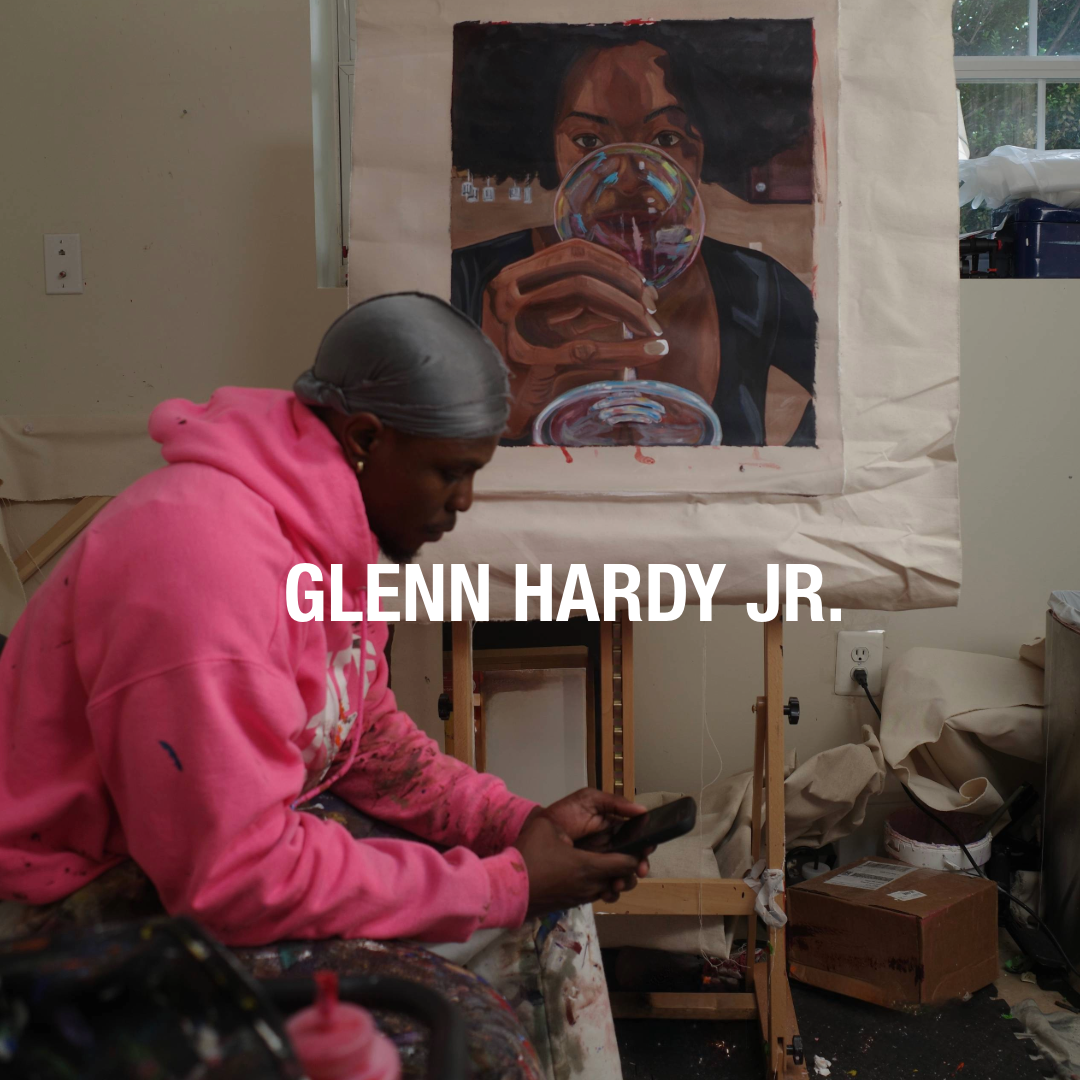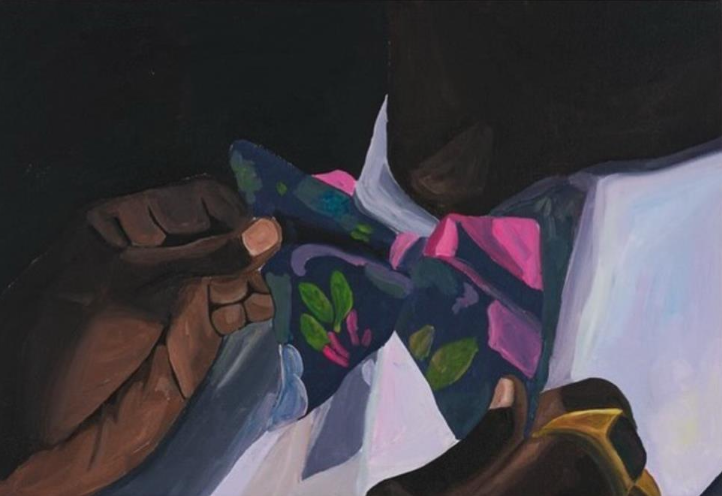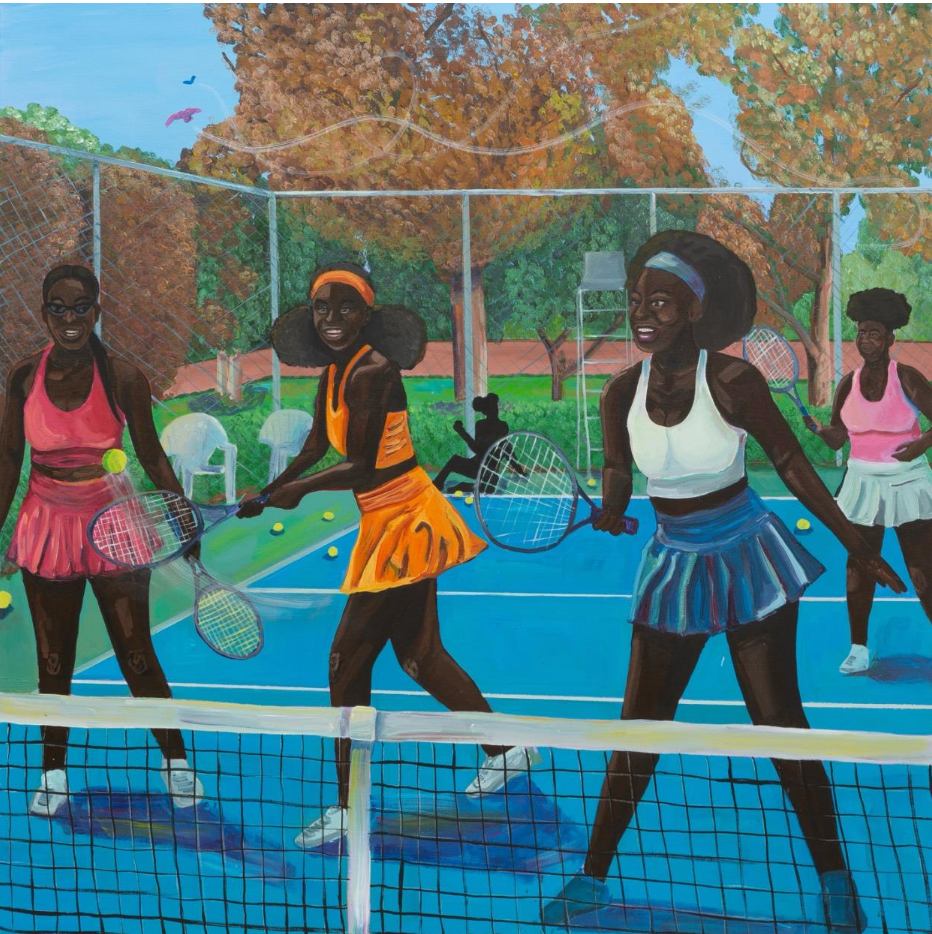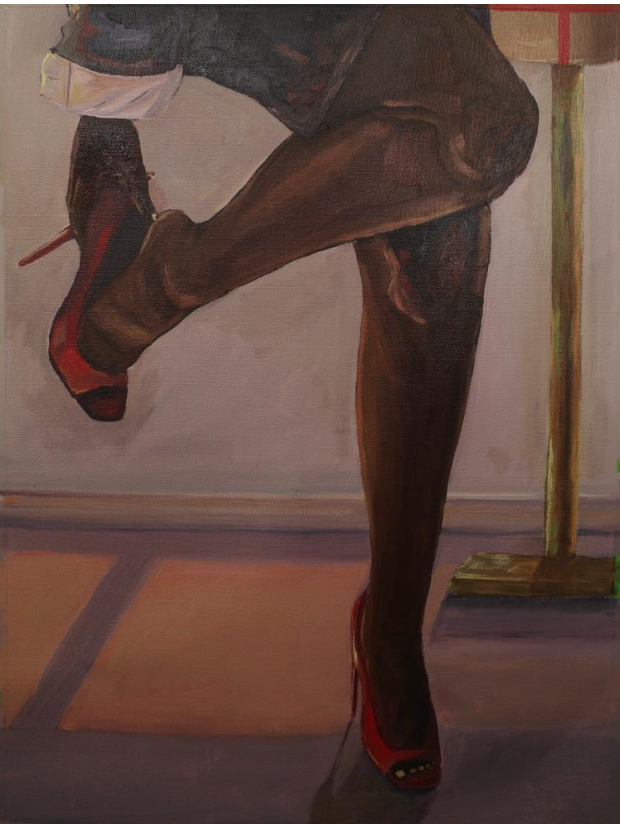Glenn Hardy Jr. is a self-taught artist whose vibrant, figurative paintings reframe everyday Black life through a lens of celebration and ease. Drawing from personal experience and inspired by visual forebears like Kerry James Marshall and Ernie Barnes, Hardy replaces reductive narratives with ones grounded in joy, dignity, and human complexity. In this candid conversation, Hardy speaks to the power of representation, the beauty of the ordinary, and why freedom, both lived and painted, is central to his creative philosophy.
What is the origin story with your relationship to art?
GH— Thank you so much for taking the time to explore my practice and show interest in my work—I truly appreciate it. My relationship with art has been going strong for a long time; I’ve loved it for as long as I can remember. I started drawing when I was about seven years old, and believe it or not, I still have some of those early sketches tucked away somewhere (though I’m slightly terrified to revisit them! lol) Back then, graphite was my go-to medium long before I even knew what the word “medium” meant. My first real painting experience came from a commission by my aunt, who asked me to create something for her living room. I bought my first set of oil paints and figured it out on the fly. Yep, I started with oils, and later switched to acrylics which isn’t the common way to do things. Since that commission, painting has been a constant presence in my life. Lately, I’ve found myself circling back to drawing, and it’s been fun.
Karats and Cheese — 2022, acrylic on canvas
Your paintings offer a vision of Black life grounded in joy, leisure, and triumph that is free from conflict. Can you speak to how you developed this visual vocabulary of liberation?
GH— Absolutely. My work is definitely rooted in black life —joy, leisure, and triumph; I do this purposely. We’ve seen and continue to see so many portrayals rooted in struggle, trauma, and adversity. Those narratives are important, but they’re not the whole story. I’m certain we’ve all experienced those times, but that negative imagery has weight to it, and seeing it in the media everyday doesn’t help. I want to give a different perspective. There is so much light in our communities; moments of celebration, tenderness, brilliance, and peace. We live vibrant, beautiful lives that deserve to be seen and honored.
You’ve said your work acts as a chronicle. When I view your work, it feels like I am viewing a picture or catching a moment in time. There is so much movement and life in your paintings. What moments, rituals, or emotions feel most urgent to archive in your work?
GH— Every painting is its own story, and I try to make sure there’s subtle movement because it makes the scene feel alive. I want viewers to not only see the work, but feel it as well. To imagine themselves there, or maybe be pulled into a memory they didn’t expect to revisit. Joy and love are the emotions I reach for most. But I’ve realized lately that joy doesn’t have to stand alone to tell a good story. Someone told me before that, “life can’t always be peaches and cream,” regarding my work, and they were right. So I’m starting to lean into the messier parts too; quiet tension, soft grief, stillness. They’re part of the picture. And sometimes, it’s those emotions that make joy shine a little brighter. At the heart of it, my work displays the everyday moments that deserve to be publicized, the ones that keep us close.

“Plastic on the Couch”, 2025, acrylic on canvas
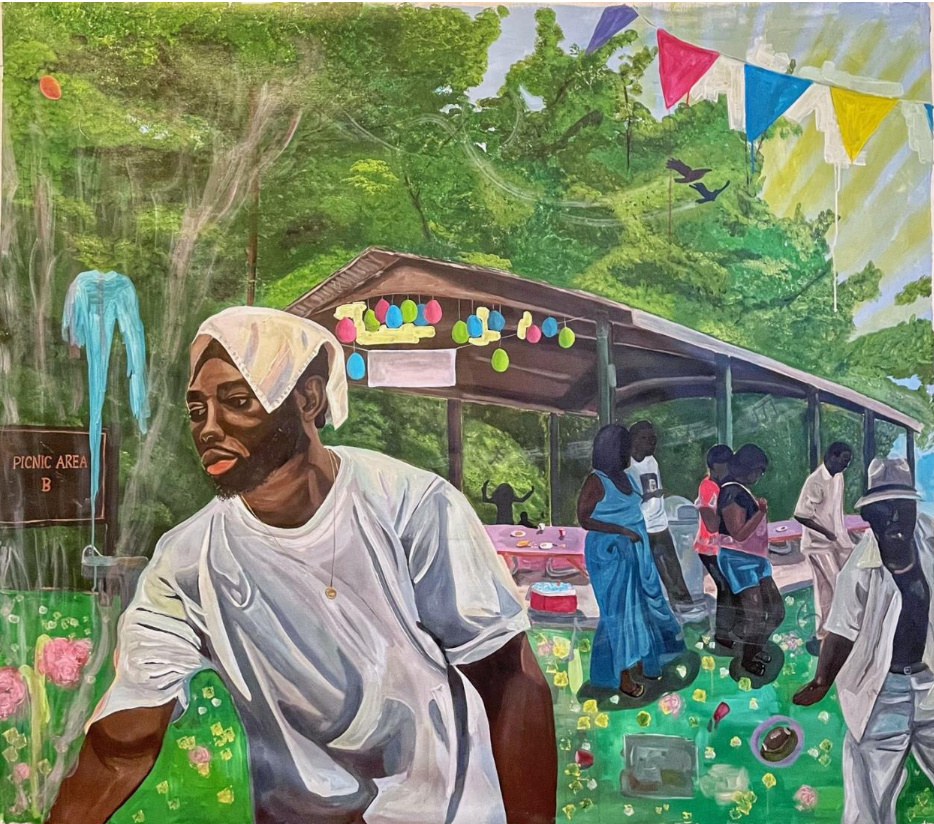
“Family Reunion”, 2022, acrylic on canvas

“Rocking Chairs on the Porch”, 2022, acrylic on canvas
That Boy Sharp — 2022, acrylic on canvas
Can you take us inside your process? What does your research or pre-painting ritual look like?
GH— I wish I could say I just walk up to the canvas and magic happens, but my process starts long before any paint touches the surface. It’s mostly research... and a little bit of chaos. My mind is constantly racing with ideas. I have sketches, reference photos, and full concept paragraphs in my phone’s notes app. Once an idea really grabs my attention I dig a little deeper, and start looking into historical references, gathering images, talking through ideas with people I trust, and sometimes even taking my own photos to get the exact feeling I’m after. Once that’s done, I’ll prep my canvas, start on the painting, and when I’m about halfway through… I scrap it and start something new lol which happens more often than not. Some pieces stay unfinished, some get painted over, and evolve into something completely unexpected. I guess it’s all part of the story.
Artist Glenn Hardy
There’s a quiet but radical joy in your paintings. Do you view joy as a form of resistance especially with the world we live in currently and even looking at history?
GH— Oh wow, this is a great question. As someone who tries to stay positive, I can definitely see joy as a form of resistance. Not in a loud way, but as something quiet and steady. It’s like second nature to me, this instinct to push back against hardship by choosing light. There’s so much history, and burden that we carry. And the world we’re living in now can be overwhelming. Joy reminds us that we’re still here, still have reason to celebrate, and still thriving. For me, joy doesn’t mean ignoring pain, it means refusing to let pain be the only story. I also know that not everyone moves through the world this way. People resist in different ways, and that diversity is part of what makes storytelling through art so beautiful. Three artists can tell the same story, but each one will choose a different lens, a different truth, a different color palette of emotion. Joy is my way of reclaiming space. Of saying, “we exist in fullness,” even when the world tries to empty that.
Much of contemporary Black figuration still grapples with visibility through conflict whether on film, TV, or even in art. What does it mean to you to opt out of that narrative?
GH— If I’m understanding the question correctly, I don’t see opting out of conflict-based narratives as removal. It’s more about balance. Conflict is definitely real—it shapes us, and it’s part of our story. But visibility through struggle doesn’t have to be the only focus. Visibility through light is a part of our story too. For me, choosing to focus on pleasure, leisure, and everyday beauty doesn’t negate those other realities. Some people just know how to tell a certain story in a better, more concise and understandable way than others, and I acknowledge that. People carry so much emotionally, historically, and sometimes you want to speak to what uplifts you. There are those of us who’ve seen the same images of pain over and over, and now feel a need to reflect something softer, something that makes you smile. I think that's just another angle of truth. Another part of the same story—told from a different room in the house.
Matching Sets — 2024, acrylic on canvas
Happiest Hour — 2022, acrylic on canvas
As a self-taught artist, how did your creative education evolve outside of traditional institutions?
GH— Man, I think about this so much! Being self-taught I actually haven’t had a close-up look at what traditional institutions offer, so it’s tough to say how my journey might have looked if I'd gone to art school. Would my style be totally different? Would I paint with more confidence or have sharper technique? Maybe. Maybe not. What I do know is that learning outside of a classroom pushes you to find knowledge in unexpected places. You become your own teacher—watching tutorials, going to galleries, soaking in anything you can. It’s a lot of trial and error... emphasis on the error. You stumble, revise, start over, and eventually, you carve a path that feels like yours. One thing I do wish I had access to is consistent critique—the kind of feedback students get in formal settings that helps them push their work further. That’s something I’m still seeking out. But honestly, every work I’ve done has taught me something. My education is untraditional, but it’s constantly evolving.
Make Your Next Move, Your Best Move — 2022, acrylic on canvas
How do you see your work contributing to a new visual language for Black identity in art history?
GH— I probably sound like a broken record at this point, but I really do see my work as speaking for the stories that often get cropped out—the picture-perfect moments that rarely make the frame. Black identity is vast, rough, and deeply personal. My upbringing is both similar and different than so many people who may not always get the chance, or have the platform to tell their story the way they'd want to. Artists like Kerry James Marshall and Ernie Barnes have had a huge influence on me. I appreciate how they captured Black life through comfort, beauty, and a kind of quiet freedom. Of course, life comes with worry—we all carry something. But there are also those moments where you kick your feet up, let the weight fall off, and live fully in the now. That’s the energy I chase in my work. I want to contribute to a visual language that shows those moments—the ones we hold onto, the ones that get overlooked but are worth of a lifetime.
Make Your Next Move, Your Best Move — 2022, acrylic on canvas
Momma I Made It — 2023, acrylic on canvas
How do you see your work contributing to a new visual language for Black identity in art history?
GH— When I envision the viewer standing in front of my work I hope they are able to walk away with a specific memory in their head, not necessarily of the work, but a time in their life that resembles a similar moment as what they saw in the work. I want the work to trigger a sense of something personal, and familiar. If they walk away thinking of a time they felt like the image in the painting, or just a little more like themselves… then I feel like the painting did its job. I want my art to be like a deep breath, or that little sigh of relief you take when everything slows down for a second. If they carry that feeling with them, even just for a moment, then mission accomplished!
Images courtesy of the artist.

